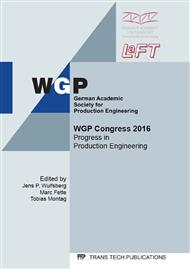p.123
p.133
p.141
p.149
p.157
p.165
p.173
p.181
p.189
Geometrical Contact Zone Analysis of the Skive Hobbing Process
Abstract:
In this paper, an innovative approach for contact zone analysis of skive hobbing is presented. This process is characterised by varying tool engagements and very small chip thicknesses. The paper describes the process-modelling and the analysis of the workpiece-tool contact. For efficient modelling, a novel dexel-based method for the description of a gear segment with discretized stock allowance is presented. Characteristic for the method is an analytical description of the target workpiece contour which allows to describe points of the surface by Cartesian coordinates on the winding off. On this workpiece contour, dexel are modelled in surface-orthogonal direction. The initial lengths of these dexel describe the stock allowance. By cutting these dexel with a tool, a time-and position-dependent prediction of material removal values, like width of undeformed chip, undeformed chip thickness or cutting directions can be obtained. Selected results are presented and interpreted.
Info:
Periodical:
Pages:
157-164
Citation:
Online since:
August 2016
Authors:
Keywords:
Price:
Сopyright:
© 2016 Trans Tech Publications Ltd. All Rights Reserved
Share:
Citation:


